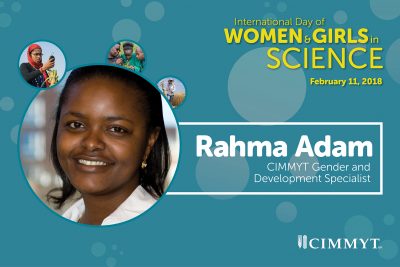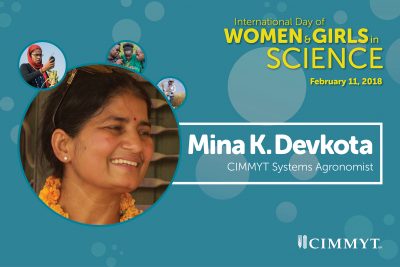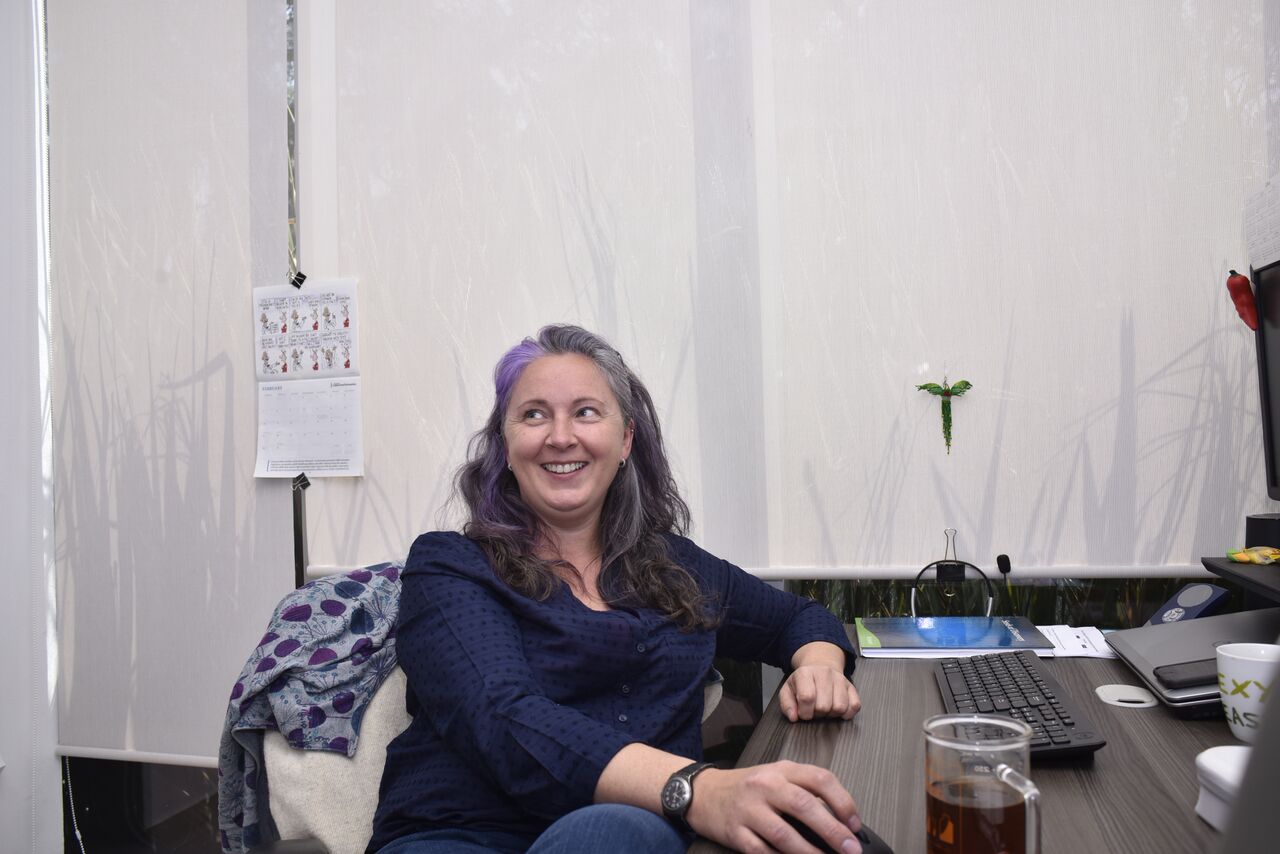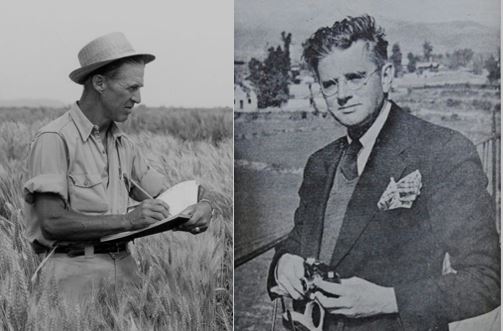Girls and women are underrepresented in the fields of science, technology, engineering and mathematics (STEM). The likelihood of female students graduating with a degree in a science-related field is much lower than for male students, according to a U.N. study conducted in 14 countries. In an effort to improve their representation, a U.N. resolution established February 11 as the International Day of Women and Girls in Science.
To celebrate the occasion this year, CIMMYT asked women involved in agricultural science to share their views on what they would like to see change.

Rahma Adam
CIMMYT Gender and Development Specialist
Nairobi, Kenya
There are two inspiring women in science, who have made significant contributions to the world. The first woman is Wangari Maathai and the second woman is Marie Curie. Maathai was the first woman in East and Central Africa to earn a doctoral degree, the first to become a professor at the University of Nairobi. She made a significant contribution to environmental/forest conservation, women’s rights and peace. In 1977, Maathai founded the Green Belt Movement (GBM), an organization focused on the planting of trees, environmental conservation and women’s rights. The GBM has planted over 51 million trees in Kenya. In 2004, she became the first African woman to win the Nobel Peace Prize.
French-Polish scientist Curie’s work led to the discovery of radium and polonium in 1898, setting the stage for nuclear medicine, which allows internal imaging of tumors. Curie is the first person and only woman to win a Nobel Prize twice, including the 1903 physics prize jointly with her husband Pierre Curie and Henri Becquerel, and the 1911 chemistry prize. She was also the first woman to win the Nobel Prize.
The key factor that will encourage women and young girls to get involved in science is to be paired up with already practicing women scientists through mentorship programs so that they see firsthand what it is like to be a female scientist, and what it takes to become one. Starting a mentorship early in life – from the primary school level – will inspire young female students to take more interest in science classes and contemplate a career in science.

Bev Postma
HarvestPlus CEO
Washington DC, United States
Women’s contributions to science are vast and immeasurable. Heroes like Jane Goodall and Marie Curie, are some of the world’s most famous scientists who also happen to be women. One of my own personal role models from the past is Antoinette Brown Blackwell, who isn’t usually remembered as a scientist, but her efforts to dismantle the barriers to women in science and other research and intellectual fields is a major source of inspiration to me. Today, I am inspired every day by the young scientists in the CGIAR, both women and men, who continue to challenge all forms of gender disparity and are making huge contributions to our body of knowledge.
Women have long contributed innovations to various scientific fields, but their efforts are not always acknowledged, remembered or encouraged as readily as their male counterparts. Women of all ages have been fighting an uphill battle to become equals in the scientific community. Progress is being made but young women still face too many barriers to enter STEM fields and there are still too many hurdles to clear once they enter the workforce. The statistics speak for themselves and must not be ignored. The world needs these women scientists and we need to do all we can to nurture them and encourage a new generation of young women to enter into STEM fields. We must encourage and excite young women about studying STEM subjects, especially in developing countries. We can do this by profiling more female role models and by ensuring that new and established scientists get their fair share of airtime in publications and on conference panels. Sadly, I still see far too many male-only panels at STEM conferences. We all have a role to play in creating a work environment that provides opportunities for everyone to succeed, regardless of gender. Together, we must continue to support and elevate woman scientists within our workplaces and throughout the CGIAR system. I pledge to do my part to support and champion this movement.

Julie Borlaug
Inari Agriculture, Inc. VP Communications and Public Relations
United States
In my opinion, getting more girls and women involved in science will create more innovation, creativity and competitiveness. Women look at issues and research in a different light than men and are often more effective in communication. We must change the current perception of science as a negative, especially in agriculture. It is my hope that women will be able to talk about the benefits of innovation and technology in a manner that makes it easier to understand and acceptable to the public.
I would like to see more STEM programs in schools as well as in after-school programs and camps to introduce girls to science at an early age. Introduction at an early age is critical to furthering their passion and interest. By the time they are teenagers, they are more influenced by their peers and it is often too late to gain their interest.
Additionally, there are many opportunities for parents to provide toys that expose girls to math, chemistry and physics at an early age. Lego sets and many science kits have lines focused solely on girls and provide an important way for girls to grow confident in their capabilities. Several web-based STEM-themed games and apps have been released to encourage girls’ interests.
We need more young female scientists to serve as mentors to girls through various media, including social media outreach. It is hard to find programs or social media activities that highlight young female scientists to inspire girls. We must make a concerted effort to change this and empower the current and future generation of scientists!

Reshmi Rani Das
CIMMYT Research Scholar
Hyderabad, India
Women and girls have made significant contributions in various science disciplines, especially in agriculture, irrespective of their social status. We know women are the major workforce in agriculture worldwide, but sometimes they are marginalized due to limited land rights. When this is the case, they have less control over resources. Women’s contributions to agriculture are significant, across the sector, starting with research and development, and including the deployment of scalable technology leading to the capacity to make an impact on humanity.
It is essential to bring women working in agriculture into the mainstream and to empower them with direct access to knowledge of improved agricultural technologies. The female presence in scientific fields has been largely disproportional compared to male; however, the trend is slowly changing, as more and more women are entering these fields.
Equality in recognition of their contributions and equal rights in ownership of the resources might work as a strong motivator for women and girls to get more involved in science. Introducing women and girls to scientific fields and encouraging them to follow their hearts and minds irrespective of social issues that influence career choices could also help overcome the negative perceptions that girls develop at a young age that science is a hard subject, leading them to avoid it. Friendly environments in high school and the university level, inviting females to participate and get over a fear of science, would encourage those with talent and a genuine interest to develop their interest.
Encouraging women to participate in training and workshops by motivating young girls to explore and challenge typically male-dominated fields could also help bolster the number of women in the field. As well as providing more financial assistance in the form of fellowships so that they become financially independent.
Parents are primary mentors, and therefore right from the beginning if there is support, women and girls can accomplish much more. The value of mentorship outside the home is also irreplaceable. In the past, we have seen the majority of successful women credit their success to their mentors for helping them reach career goals.

Mina K. Devkota
CIMMYT Systems Agronomist
Kathmandu, Nepal
Many girls begin making a significant contribution to science from a very early age. As they grow older, a sizeable portion of them will work in various research organizations, contributing to science in different fields. Women often also play a big supporting role in the successes of men working for science. Thus, women, directly and indirectly, contribute to scientific advancement.
In my opinion, enabling environments in family, society and in communities, promoting knowledge gathering, support for education and career development will encourage more women and girls to get involved in science. For example, in some countries, certain people have the mindset that women and girls must still be confined to household activities, an unfair bias limiting access to opportunities and exposure to science.

 Gender equality, youth and social inclusion
Gender equality, youth and social inclusion 